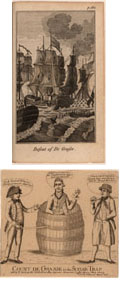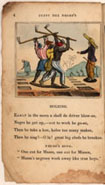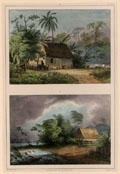SUGAR AND CONFLICT One of the costs of slave-produced sugar was conflict at every level. Slaves rebelled individually and collectively against their masters. Wars were waged in the Atlantic and around its perimeter over control of sugar colonies and the slave trade. Nature was often viewed as a hostile force, bringing hurricanes, extreme heat, and diseases that attacked both humans and the sugarcane. Although most prints concerned with the sugar economy projected peace and harmony, others—across a wide range of genres—portrayed conflict as violent, grotesque, and even comic. |
||
Sugar Wars on the Seas "Count De Grasse in the sugar trap," etching. London: T. Barron, May 28, 1782. The British and French warred over the West Indian sugar colonies for much of the eighteenth century. In April 1782 the French allied with the Spanish in an attempt to wrest control of Jamaica from the British. In the Battle of the Saintes (islands between Guadeloupe and Dominica), the Royal Navy under Admiral Romney, defeated the French fleet commanded by the Comte de Grasse. Around seventy warships were involved; there were 2000-3000 dead, and 5000 French soldiers and sailors were captured. The scale of the battle and losses give some sense of the importance of Britain’s most profitable colony. The defeat of De Grasse was treated in this naval battle scene showing his ship on fire, and mocked in this crude satire. In the satire, the French admiral is shown stuck in a sugar hogshead, and placed between Admiral Rodney and a British sailor. |
||
Mixing Work with War Van den Broeck, who wrote the personal journal in which this print appeared, was a soldier for the Dutch West India Company in the late 1640s, when the Dutch attempted to put down a revolt by the Portuguese that led to the latter's takeover of Brazil in 1654. |
||
Hoes as Weapons? |
||
Aggressive Planting There is little doubt that these three powerful slaves have more on their minds than just holing cane. The planter, whip held low, seems unaware of the violence that is about to erupt. The engraving is from an anti-slavery children's book that uses humor and irony, as well as sentimentality, to convey its message. |
||
Nature, Calm and Untamed The lower image on this page is rather unusual. Storms and hurricanes were ever-present threats to sugar plantations in the Caribbean; they were often discussed, but rarely pictured. Benoit manages this natural threat first by pairing a calm scene with a stormy one, and second, by focusing on a slave hut, not a mill, cane field, or plantation house. These contrasted views might well have been interpreted as symbolizing the threat posed to the colony by the end of slavery. Storms often symbolized human conflict in nineteenth-century art. The British ended slavery briefly when they occupied Suriname, but the Dutch reinstated it, only abolishing it in 1863. |
||
Exhibition may be seen in Reading Room from SEPTEMBER 2013 through december 2013. K. Dian Kriz (Professor Emerita of History of Art and Architecture, Brown University), guest curator, with assistance from Susan Danforth (Curator of Maps and Prints); Elena Daniele (JCB Stuart Fellow 2012-13), curatorial assistant. |


Images: "The Buildings of Maran Estate in the Island of Grenada. The Property of Thomas Duncan Esqr. Novr. 1822."




